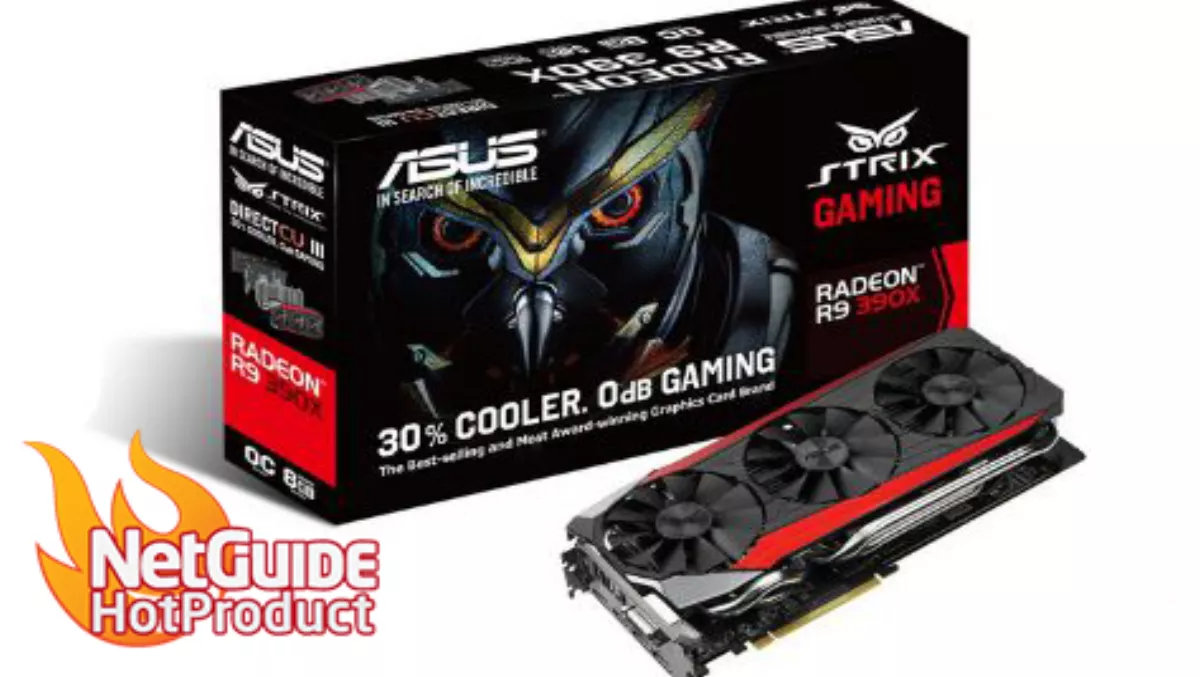
Hands-on review: ASUS STRIX Radeon R9 390X 8GB
For a considerable amount of time AMD have been playing catch up with NVIDIA's GPUs. The vanilla Radeon R9 390X is intended to compete with NVIDIA's GTX980, but I've been looking at the ASUS STRIX version of the Radeon R9 390X 8GB, which is a different, and rather special, beast entirely.
The 390X is powered by AMD's Grenada GPU, which is a refined version of AMD's two-year-old Hawaii GPU found in the 200 series. The result is a tweaked GPU that runs faster and cooler.
The 390X also has 8GB of fast GDDR5 memory - this is twice as much as NVIDIA's GTX980 and 50% more than the more expensive GTX980ti.
This being an ASUS STRIX model, it comes with a few very special additions. First off, the card has a back-plate to keep it rigid and to keep fingers away from the delicate circuit board.
Next, you can't fail to notice the 10mm heat pipes that weave themselves around the heatsink fins. There's actually two chunky heat pipes paired with three additional heat pipes for a total of five (2x10mm, 2x6mm and 1x4mm) which, when teamed up with the triple wing-blade 0dB fans, make the card virtually silent.
In fact, due to the cooling afforded by the heatsink and pipe alone, the fans can actually switch off when the card is not under load. According to ASUS, the DirectCU III heatsink design provides 30% more cooling at 3x less noise than the AMD reference design. Practically speaking, the card is quiet. Very quiet indeed.
I run two NVIDIA GTX980s in SLI and I can tell you right now they make one hell of a din, especially if I'm messing about with overclocking.
The ASUS STRIX Radeon R9 390X 8GB is silent in comparison, making it the perfect card for a dual or triple crossfire arrangement - but more on that later.
Anesthetically, this is a great-looking card. With the fancy STRIX LED lighting around the fan housing, the card looks quite stunning glowing away in a windowed PC case.
My gut feeling was that the STRIX 390X would be playing second fiddle to my trusty GTX980, and for some of the benchmarks it was, but for a many the 390X was on par with or faster than my GTX980.
Whilst playing, the performance between the two cards was pretty much indistinguishable. But, whilst recent games at standard resolutions don't seem to faze either card, with a ridiculous 8GB of RAM the STRIX R9 390X is still going to be laughing when pumped with ultra-hi-res textures to fill a large screen, whereas my GTX980 is likely to feel a little stressed. This is a card that's built for the future.
And about that future, I can't help but salivate at the idea of putting two or even three of these beasts together in a multi-GPU CrossFire setup.
That would be enough graphical horsepower to keep even the most discerning gamer happily playing in Ultra High Definition for the next few years. And of course, unlike my NVIDIA set-up, a system running multiple 390X cards with ASUS' DirectCU III cooling solution won't sound like a jet engine.
The only down-side of the virtually silent cooling solution I could see was that the ASUS STRIX Radeon R9 390X ran a little hotter than my GTX980 when pushed (using the Valley demo). Though, this can be attributed to the differences between the AMD and NVIDIA micro-architectures.
This is a bit academic, and only really going to need addressing if you are overclocking. If you do, you are going to push the fans to a higher rpm trading-off the speed increase against what is still going to be very little noise.
And on the subject of overclocking, the ASUS STRIX Radeon R9 390X 8GB has a factory overclocked core of 1070Mhz compared with the reference clock of 1050Mhz. Using the OC mode initiated with the included GPU Tweak II software the card is easily overclocked further to 1090Mhz.
The card is compatible with AMD's FreeSync monitor system, offering lightning-fast and perfectly synched refresh-rates for an optimum gaming experience.
Also, with three DisplayPort sockets, a HDMI socket and a DVI socket, the card is ready for multi-monitor set-ups using AMD's Eyefinity technology - something that I can't recommend enough for some serious gaming.
In the box you'll also find a copy of the ASUS GPU Tweak II overclocking tool and a 1-year premium subscription to XSplit Gamecaster, for recording and publishing game footage online.
The ASUS STRIX Radeon R9 390X 8GB is a viable alternative to NVIDIA's previously unbreakable stranglehold on the GPU marketplace.
Indeed, it was a pleasant surprise to find a card that can hold its own against an NVIDIA GTX980, let alone one that costs less and comes with a staggering 8GB of GDDR5 memory.
Also, ASUS' STRIX design styling makes this a beautiful-looking card and a lot quieter than you'd expect. This is truly a gamers graphics card, and one built with the future in mind. It's certainly made me think again about my choice of GPU.
9.5/10



